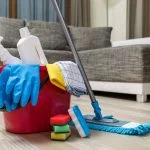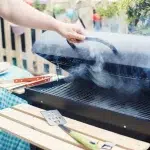A pool can be an inviting spot, but only when the water is clear, tiles are free of mineral film, and there’s no mould in sight.
Be it sparkling, modern mosaics of classic Spanish-style ceramics, with hygiene and cleaning your spa, pond, or pool tiles, the area at the waterline is most susceptible to stains. This is where tiles meet air and thus trigger a chemical reaction that fungi, mineral build-ups and various discolouration agents simply love.
However, sometimes you should drain the entire pool to scrub tiles and thus keep tile work healthy and free from additional maintenance. It is quite popular to tile only the water edging in in-ground pools, making the cleaning process much more manageable.

As professional tile and ground cleaners, at Pauls Cleaning Company (Melbourne) we know that colleagues from the pool cleaning branch recommend draining, cleaning, and refilling an in-ground pool every 5-7 years unless a severe problem deems earlier attention.
Why Do Pool Tiles Get Dirty?

It may seem a usual event for pool tiles to build up a layer of white “scum†on the side, just above the water level. Natural evaporation reduces the waterline and leaves it vulnerable to staining. Having high pH levels or high alkalinity as H2o evaporates causes Calcium to adhere along the path of the water’s edge, slowly going down. The ideal numbers are pH of 7.4 and alkalinity ranging between 80 and 120 PPM (parts per million).
Also, an inadequate chemical imbalance of pool-water chemicals causes scales and stains to appear at the water’s edge. That’s why basic know-how of what and why pool water needs, so you stay away from problems.
On general occasions, it is scale or stain that causes discolouration, but so do falling leaves that stick to the sides.
Is all calcium build up the same? No.
You have two primary culprits:
- One is Calcium silicate, and it’s the toughest of the two as it usually takes longer to form. Also known as Silicic acid, calcium salt, and calcium silicon oxide, it comes in a colour drifting from white to grey and is not affected by muriatic acid. You need a pumice stone to get it off.
- The second is Calcium carbonate. If you see it bubbling after muriatic acid treatment, then you have a match.

Mind both and scrub tiles in time.
What Causes Mineral Build-ups?
Again, we have two primary culprits:
- Extreme heat;
- Hard water.
Having both makes cleaning pool tiles a nightmare.
How to Clean Stains & Scale
The one best solution is to be consistent with the cleaning and maintenance of your pool, just like you should do with your BBQ.
Equip yourself with a soft brush and do a bit of scrubbing twice a week as part of your maintenance routine and you’ll keep algae, mould, and dirt gross away.
However, if you want to stay chemical-free, there are always classic recipes. Just note that the following would work only if waterline grime is light:
- Good old baking soda;
- The classic Borax;
- The well-known vinegar;
- Fluorine-based toothpaste;
- And dish soap.
Cases that go beyond “stage 1†require a professional approach.
Regular Maintenance Measures
Regular upkeep of your pool and pool tiles is the best way to stay on top of built-up dirt and film, not to mention up keeping a healthy & non-toxic environment for children.
- Keep leaves and grass clippings from clinging to the sides of tiles.
- Brush the tiles in circular motions to keep calcium carbonate from building up.
- If working on these areas every couple of days, vinegar and water, baking soda and vinegar can reduce the damage.
Nothing helps keep the pool clean as prevention.
Pressure Washing Pool Tiles
If you are a DIY’er when it comes to in-ground pool maintenance, renting a pressure washer may be a good option for you. This is the best way to clean a pool tile that is safe and chemical-free.
You need no detergents for pressure washing. Pressurised steam set at 2000 to 2600 PSI can remove built-up dirt, mould, and calcium deposits.
Scrubbing Pool Tiles
A detergent-based spray cleaner and a stiff nylon brush can be used. Spray the area and put elbow grease to work as a pool tile scrubber. Depending on the size of your in-ground pool, this could be a job for a few people to handle.
Utilise Acid for Washing Tiles
We do not recommend acid washing for the average layman because of the dangers associated. It delivers excellent results, though. You should only use this procedure to drain and clean the interior surfaces.
- Mix equal amounts of muriatic acid (HCL) and water.
- Scrub the floor with an acid-proof brush.
- Use ~1 kg soda ash to 4 litres of muriatic acid to neutralise the acid, then rinse thoroughly with fresh water.
- Use protective clothing, including a mask, goggles, and rubber gloves on the hands and feet is a must during this process.
Simple and efficient.

Commercial Cleaners
Professional pool cleaners are trained to recognise different types of stains and deposits that have built up on your pool tiles. Different products are recommended depending on the kind of dirt buildup on the tile and grout.
Calcium carbonate scaling will appear as a flaky white crust. In addition to commercial cleaners, a pumice stone and diligent scrubbing are alternatives. Calcium silicate is a problematic type of scaling to remove. It appears as white-grey scum and is very hard to remove.
Pool maintenance and tile cleanup can be a challenge in today’s busy world. Sometimes it is easier to contract a pool cleaning company to stay on top of your pool’s health. Pool tiles can cost around $50 to $95 per square metre when maintenance has not been performed regularly.
Follow Our Tips & Keep Pool Tiles Clean
If you find yourself lacking the time for the care of your pool, several pool maintenance companies in Australia are experienced and ready to give you a quote.
Follow these tips when you find yourself lacking the time for the care of your pool, as pool maintenance professionals in Australia are experienced and ready to help.






